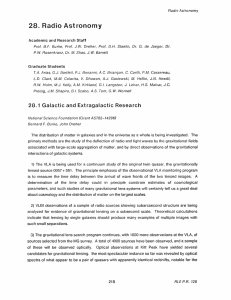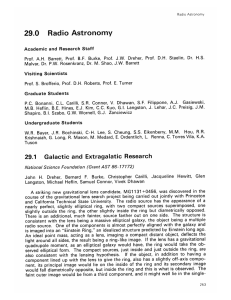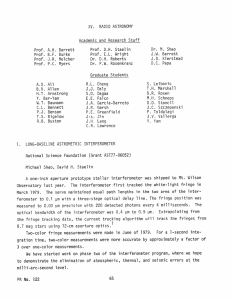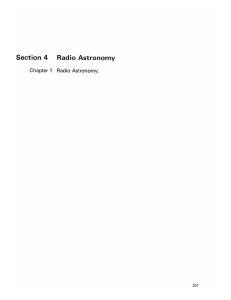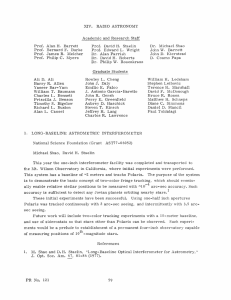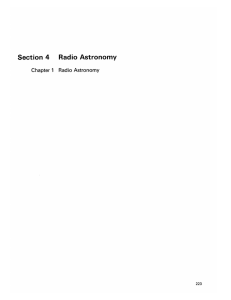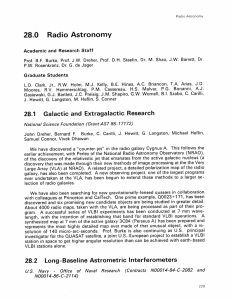14. Radio Astronomy Staff
advertisement
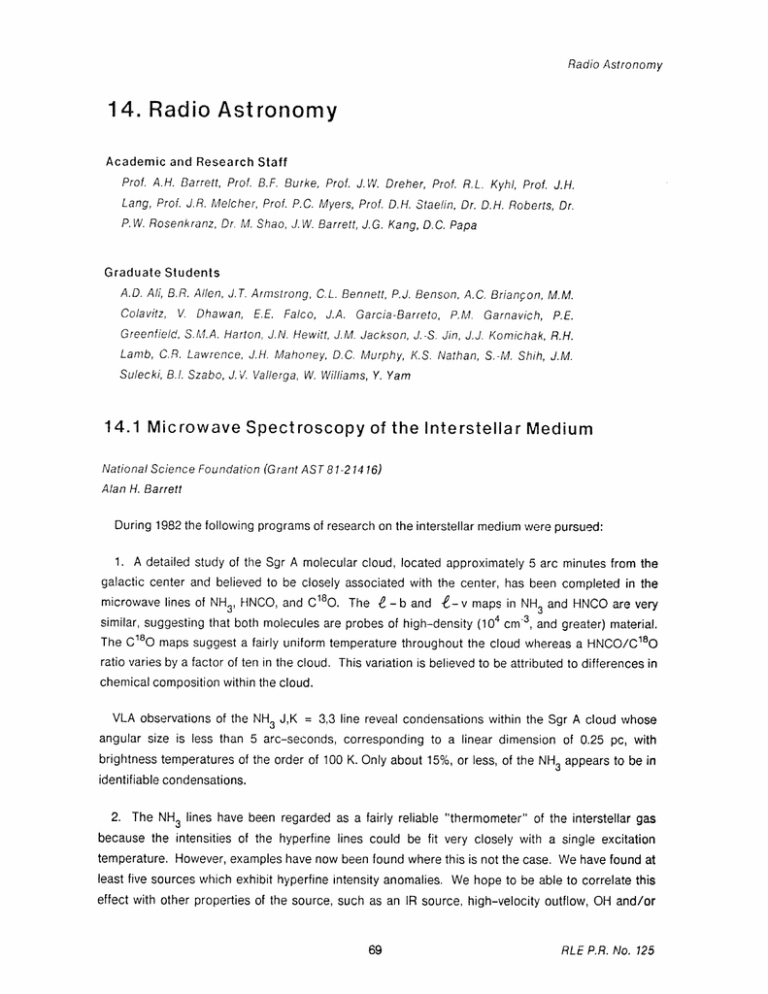
Radio Astronomy 14. Radio Astronomy Academic and Research Staff Prof. A.H. Barrett, Prof. B.F. Burke, Prof. J.W. Dreher, Prof. R.L. Kyhl, Prof. J.H. Lang, Prof. J.R. Melcher, Prof. P.C. Myers, Prof. D.H. Staelin, Dr. D.H. Roberts, Dr. P.W. Rosenkranz, Dr. M. Shao, J.W. Barrett, J.G. Kang, D.C. Papa Graduate Students A.D. All, B.R. All//en, J.T. Armstrong, C.L. Bennett, P.J. Benson, A.C. Briancon, M.M. Colavitz, V. Dhawan, E.E. Falco, J.A. Garcia-Barreto, P.M. Garnavich, P.E. Greenfield, S.M.A. Harton, J.N. Hewitt, J.M. Jackson, J.-S. Jin, J.J. Komichak, R.H. Lamb, C.R. Lawrence, J.H. Mahoney, D.C. Murphy, K.S. Nathan, S.-M. Shih, J.M. Sulecki, B.I. Szabo, J.V. Vallerga, W. Williams, Y. Yam 14.1 Microwave Spectroscopy of the Interstellar Medium National Science Foundation (Grant AST 81-21416) Alan H. Barrett During 1982 the following programs of research on the interstellar medium were pursued: 1. A detailed study of the Sgr A molecular cloud, located approximately 5 arc minutes from the galactic center and believed to be closely associated with the center, has been completed in the microwave lines of NH3 , HNCO, and C18 0O. The ý - b and P- v maps in NH3 and HNCO are very similar, suggesting that both molecules are probes of high-density (104 cm -3 , and greater) material. The C' 80 maps suggest a fairly uniform temperature throughout the cloud whereas a HNCO/C 18 0 ratio varies by a factor of ten in the cloud. This variation is believed to be attributed to differences in chemical composition within the cloud. VLA observations of the NH3 J,K = 3,3 line reveal condensations within the Sgr A cloud whose angular size is less than 5 arc-seconds, corresponding to a linear dimension of 0.25 pc, with brightness temperatures of the order of 100 K. Only about 15%, or less, of the NH3 appears to be in identifiable condensations. 2. The NH3 lines have been regarded as a fairly reliable "thermometer" of the interstellar gas because the intensities of the hyperfine lines could be fit very closely with a single excitation temperature. However, examples have now been found where this is not the case. We have found at least five sources which exhibit hyperfine intensity anomalies. We hope to be able to correlate this effect with other properties of the source, such as an IR source, high-velocity outflow, OH and/or RLE P.R. No. 125 Radio Astronomy H2 0 masers, etc. 3. The molecular clouds in the Taurus region have been studied in the CO line at 2.6 mm. A large amount of data was acquired, using the 1.2 m telescope of Columbia University and the Goddard Institute of Space Studies, and is not fully reduced. However, one significant conclusion is the detection of a large shell of CO surrounding a group of T-Tauri stars. This shell may have originated from the mass loss of the T-Tauri stars. 4. A deep, continuum study of the Sgr A molecular cloud with the VLA at 6 cm and 2 cm has revealed the presence of both thermal and nonthermal sources in the cloud. These sources were previously undetected but their relationship to the cloud is quite clear since they have a positional coincidence with the NH3 peaks in the cloud. Further studies are planned. 14.2 Galactic and Extragalactic Radio Astronomy National Science Foundation (Grant AST80-22864) Bernard F. Burke Gravitational Lenses The work of Greenfield, Roberts, and Burke on VLA studies of the double quasar 0957 + 561 is nearing publication. This massive study, which consisted of observing the object at wavelengths of 2, 6, 18, and 21 cm, covered the period June 1979 - December 1980, and included studies of the spectra, polarization properties, and gravitational lens properties of the object, was summarized in the thesis of P.E. Greenfield as follows: 1.The radio map gives more constraints on possible lens models, and the only acceptable models fall within a narrow range of parameters. The original "double ellipsoid" model is unacceptable, but by relocating the mass associated with the foreground cluster and changing its scale length, asatisfactory fit can be found to the data. 2. Time variations seem to have occurred during the early periods of observation that may give an interesting new class of cosmological measurement. 3.The two quasar images are polarized, and exhibit different rotation measures. The rotation measure of the B quasar, which is seen shining through the giant cD galaxy in the foreground, is greater by 100 rad/m 2 , implying an average magnetic field of about 1 pG through a 10-2 el/cm3 pathlength of 104 pc, which seems remarkably high. We are investigating the anomaly further. In May 1982, we reobserved the object with the additional collaboration of J.N. Hewitt and A.K. Dupree. The B and G images show irregularities that are consistent with those present in the December 1980 data. Now, with the perfection of self-calibration routines at the VLA; we have been RLE P.R. No. 125 Radio Astronomy able to improve the results greatly. Greenfield's model (developed in 1981) predicts the observed anomaly in the B image, and the extended nature of the G source, partly associated with the galaxy, has raised interesting questions about the nature of the third image. We have also been reexamining the mass models, and contliuifng our time-variation studies of the quasar images. We believe that the double quasar data now gives the best-defined value of the mass-to-light ratio ever determined for a cluster of galaxies. 14.3 Interacting Galaxies The pair of galaxies NGC 4038/39 (known as "the antennae") have been observed at 21 cm by the VLA in both the C and D arrays. Theoretical studies are now in progress to use these new data to derive the orbital history of the pair of galaxies, and to see if the combined morphological and velocity field information can also give new data on massive halos associated with the galaxies (a massive halo gives a softening of the galactic gravitational field when test particles travel close enough). So far, we conclude that: 1. The conventional interpretation is not an accurate representation, since one long tidal arm for each galaxy is not consistent with the dynamics that the new data demand (the work of Toomre and Toomre was, after all, only intended to be a first demonstration of the reasonability of forming long tails by tidal interactions). 2. The only long arms probably are connected to only one of the two galaxies. 3. The orbital history of the interacting pair can probably be specified with some precision. The final purpose, the search for evidence for a massive halo, will require the completion of the orbital analysis before a definitive statement can be made. 14.4 The 6 cm Radio Survey The next step has been to observe the entire band of sky between - 30 and + 200 with the 300-ft. transit telescope of the NRAO. This survey has now been completed and consists of analysis of the gain of the 300-ft. telescope as a function of position and time, and of the time variability of the 123 calibrator sources. 14.5 Morphology and Optical Identifications We have been able to derive a list of 1000 sources for detailed study from the MA survey. These were observed with the VLA at 6 cm to get accurate positions, and 992 of the source positions were measured on the Palomar Sky Survey Plates for optical identifications. This work formed the Ph.D. thesis of C.R. Lawrence at M.I.T. A number of interesting conclusions can be drawn from this work, which is the largest single optical identification study yet undertaken: RLE P.R. No. 125 Radio Astronomy 1. 50% of the sources having flux greater than 150 mJy, and 39% of those fainter than 150 mJy, have visible optical PSS counterparts. 2. 45% of the sources have flat spectra (|al < 0.5). Roughly 2/3 of these have optical PSS counterparts. 3. The steep spectrum sources only have an identification rate of 30%, and the empty field sources tend to have the steepest spectra. 4. Almost half the observed sources are unresolved with the VLA. 5. The easily recognizable class of double radio sources has the lowest PSS identification rate (15%). These exhibit separations ranging from 0.3 to 100 arc-sec. Many of them are undoubtedly distant radio galaxies, some are probably quasars. If the morphology can be better understood, these may prove to be a most interesting cosmological probe. 6. An easily recognizable class of triple sources has been founa, and a surprising fraction (80%) have PSS counterparts, setting them aside most clearly from the double class discussed above. Their spectral indices are unusually steep. 7. There is no correlation between radio spectral index and likelihood of identification. 8. Over 25% of all steep spectrum sources are less than 1 arc-second in size. These have a PSS identification rate of 42%, higher than for extended steep-spectrum sources, but much lower than for unresolved flat-spectrum sources. 14.6 Interstellar Masers The study of the full Stokes parameters for the OH maser W30H has been completed, and is nearly ready for publication. The magnetic field is remarkably uniform for these maser sources; the field for all 6 clear Zeeman pairs is 5 ± 1 gauss, and pointing away from us in all cases. The follow-up experiment, performed February 1982, is still in the reduction process. 14.7 VLBI Studies A 327 MHz VLBI experiment, in collaboration with R. Simon of NRL and others, is being planned for October 1983, and we will take responsibility for the Haystack electronics and operations. Polarization studies of continuum sources at milliarcsecond resolution have been carried out in collaboration with D. Roberts of Brandeis. The first experiment was successful, and the data have been reduced at Brandeis. A new experiment, to be carried out in late 1983, is being prepared for. The 7-mm cooled mixer that was built by B. Allen as part of his Ph.D. thesis in Electrical Engineering at M.I.T. has been operated on the Haystack radio telescope successfully. The first tests were made in the single-dish mode, observing SiO masers as test sources. The total single-sideband system temperature was 350 K, with a device temperature of 250 K. The NRAO maser is less noisy, RLE P.R. No. 125 Radio Astronomy but has a far narrower instantaneous bandwidth. New devices now on the bench will undoubtedly replace this mixer eventually, but it is currently the best fully operable 7-mm mixer on any radio telescope. A VLBI experiment at 7-mm is currently being planned jointly with K. Johnston of NRL. 14.8 Planned Program, 1983-84 1. The gravitational lens work will emphasize continued studies of 0957 + 561, plus a new program to look for many more gravitational lens examples. We plan to examine 3000 sources with the VLA, and expect 5 to 10 new examples of gravitational lenses. It turns out that the "snapshot" ability of the VLA makes it far more advantageous to use the VLA to find the candidates, following up later with optical verification, than the other way around. 2. The studies of interacting galaxies will continue. The NGC4038/39 work will now emphasize theoretical studies, while we will be proposing VLA 21-cm line studies of new candidates. 3. The MG survey will be completed. We have proposed a new section of the survey, to cover declinations 200 to 500, since our extensive software library will allow us to extend the survey with very little expenditure of manpower. 4. Correlations of radio and optical properties of radio sources will continue. Here, the work of Lawrence et al., has generated an exciting new range of projects. The highest priority will be to obtain redshifts of a number of sources (only 21 of the 602 sources studied have measured redshifts). One sharp result of Dr. Lawrence's work is the derivation of the number of measured redshifts needed to distinguish between pairs of models presented by Peacock and Gull (MN 195, 611 (1981)). Strong sources (5 GHz S > 1 Jy) cannot do the job, because more sources would be required than exist in the sky; only by going to fluxes in the range 50-150 mJy can there be a reasonable expectation of distinguishing models. 5. Work on VLBI studies of interstellar masers will continue, but the emphasis of the work will shift to H20 and SiO masers. 6. The continuum VLBI work will consist of 4 parts: collaboration with the Brandeis group on polarization studies will continue, 7-mm VLBI techniques, still in developmental stages, will be pursued, low-frequency VLBI will continue at 327 MHz while we prepare a still longer-wavelength experiment, and the new initiative described under (7) below will require VLBI observations in many cases. 7. The morphological and identification work of Lawrence has generated a new class of radio and optical projects. There are 318 point sources, of which 175 have OSS counterparts. Over half of these are almost certainly quasars, and these constitute the largest radio-selected sample currently available. The taking of spectra of these will require collaborators, who are currently being sought out. The 92 double sources, mostly have no PSS counterpart, will be examined at other frequencies with the VLA, and searches for faint optical counterparts down to m , 24 will be carried out with the MASCOT CCD at the McGraw-Hill Observatory. There are 46 sources in a category RLE P.R. No. 125 Radio Astronomy called "core-double". These doubles with an obvious nuclear source near the mid-point (and clearly distinguishable from the "triples"-there are only 15) will receive immediate optical follow-up. Finally, we are planning to use the Arecibo telescope to reobserve all 1000 sources in our VLA sample at 21 cm to obtain a set of uniform spectral indices. The fluxes will be directly comparable with the 300 ft. 6 cm measurements since the beamwidths are about the same size. 14.9 Jovian Decametric Radiation NationalAeronautics and Space Administration (Contracts S-10665-C and NAG W373) David H. Staelin, Philip W. Rosenkranz, Peter M. Garnavich The Planetary Radio Astronomy (PRA) experiment on the Voyager 1 and 2 spacecraft observed Jovian decametric radio emission in 198 channels distributed over the band from 1.2 kHz to 40.5 MHz. "Arcs" in the frequency-time domain have been associated with radio emission near the local electron-cyclotron frequency with a hollow conical emission pattern. Theory suggests that such conical emission might be produced by magnetospheric currents generated by the satellite lo as it traverses the magnetospheric fields. These currents, on the order of 106 amps. are believed to propagate in an Alfven wvave that is reflected repeatedly between the northern and southern Jovian ionospheres. These currents traveling along the magnetospheric field lines should be spaced in Jovian longitude by an amount that depends upon the Jovian magnetic field strength and the plasma density in the magnetosphere, which is dominated by the plasma located in the "plasma torus" produced near the orbit of lo by volcanic activity. It would be natural to associate the spacing of the Jovian arcs with the spacing between the separate reflections of the lo-generated currents. In part to test this hypothesis a catalog of 200 arcs and 200 arc gaps was constructed from the Voyager 1 and Voyager 2 decametric data. Work began on relating these observed arc characteristics to the Alfven-wave model. Jovian S-bursts, in contrast to the Jovian arcs, have durations on the order of milliseconds. Certain S-bursts that are V-shaped in the frequency-time domain were studied theoretically and were successfully explained as arising from dense bunches of coherent electrons produced by ~ 10 Hz longitudinal modulation of ~ 1 keV superimposed on outward-moving ~ 2.5 keV electron beams moving in or near the lo magnetospheric flux tube. This ballistic model for S-bursts suggests the degree of coherence in the emitting electrons, a lower boundary for magnetospheric ion densities, and an interpretation for the origin of L-burst emission. References 1. D.H. Staelin and P.W. Rosenkranz, "Formation of Jovian Decametric S-Bursts by Modulated Electron Streams," J. Geophys. Res. 87, pp. 10401-10406, Dec. 1, 1982. RLE P.R. No. 125 Radio Astronomy 14.10 Long-Baseline Astrometric Interferometer National Science Foundation (Grant AST79-19553) M.I.T. Sloan Fund for Basic Research Michael Shao, David H. Staelin, M. Mark Colavita, Peter M. Garnavich During 1982 the Mark II optical astrometric interferometer was successfully used to track stellar fringes for the first time at Mount Wilson Observatory in California. This instrument has two 10-inch siderostat mirrors 3.4 meters apart in a north-south direction. Within the - 2-inch aperture the positions of red and blue fringes are independently estimated every ~ 2-10 ms, thus permitting the state of the atmosphere to be measured and compensated over time intervals sufficiently short that the atmosphere can be considered "frozen". It was discovered that the instrument was too narrowband to permit the two-color technique to work successfully. This was due to a defective beamsplitter and mirrors that were degraded in the blue portion of the spectrum. It further appeared that the optical dispersion in the two bands of the interferometer were slightly mismatched, which reduced fringe visibility. These deficiencies are now being corrected. The primary purpose of the Mark 11experiment is demonstration and evaluation of the two-color technique for obtaining relative astrometric positions accurate to - 10-3 arc sec rms for stellar separations < ~ 1 o. Experiments to demonstrate wide angle (Q 100) and absolute astrometry are also being planned for the Mark II instrument in collaboration with the Naval Research Laboratory. Future versions of the interferometer are expected to achieve 10-4 arc sec relative position accuracy over 1-20 stellar separation, which would be adequate to detect a Jupiter near a one solar mass star at a distance of several parasecs, with asignal-to-noise ratio of ~ 10. 14.11 Tiros-N Satellite Microwave Sounder National Oceanic and Atmospheric Administration (Grant 04-8-M01-1) Philip W.Rosenkranz, David H. Staelin, Krishna S. Nathan The National Oceanic and Atmospheric Administration (NOAA) routinely reduces data from one or two operational polar orbiting weather satellites; these now carry infrared spectrometers and a four-channel passive microwave spectrometer (MSU) for the purpose of mapping the three-dimensional temperature field of the atmosphere at six- or twelve-hour intervals. The purpose of this research program is continued improvement in the utilization of the passive microwave data produced by these NOAA satellites. Work continued on a study of the growth of initial-state errors in numerical weather prediction RLE P.R. No. 125 Radio Astronomy models. These experiments used the National Center for Atmospheric Research computer. The method involved the addition of perturbing functions to the initial wind and temperature fields. A class of test functions was found which avoids the generation of gravity waves in the model. On October 1,1982, support for this work was switched to NASA Grant NAG5-10. A two-dimensional temperature profile retrieval algorithm was written and tested for MSU data. The two dimensions are vertical and along the satellite track. This algorithm is a minimum-mean square error spatial filter of the type described in Ref. 1. It showed lower temperature errors than a comparable one-dimensional (vertical) retrieval, even when instrument noise was subtracted from the one-dimensional retrieval errors. This improvement was attributed to the additional information introduced by horizontal correlation of atmospheric temperature statistics. References 1. P.W. Rosenkranz, "Inversion of Data from Diffraction-Limited Multiwavelength Remote Sensors, 1, Linear Case," Radio Sci. 13, 1003-1010 (1978). 14.12 Improved Microwave Retrieval Techniques National Aeronautics and Space Administration (Grant NAG5- 10) Philip W.Rosenkranz, David H.Staelin, Krishna S. Nathan This program is directed toward development of improved techniques for retrieval of atmospheric temperature, wind, and humidity fields from passive microwave measurements of the earth, as obtained from satellites. Work on a robust scheme for retrieval of water vapor profiles from measurements near 183 GHz was concluded this year. The results were published in Ref. 1. Studies of the growth of errors in a numerical weather prediction model were shifted from NOAA support to support by this grant during the year. The purpose of this work isto understand how initial errors introduced by remote sensing systems impact forecasts, and the implications for design of global monitoring sytems incorporating satellite sensors. In a preliminary series of numerical experiments run on the National Center for Atmospheric Research computer, we found that the initial wind error was most important in determining the growth of forecast error with time. Temperature forecast errors were largely produced by differential advection of temperature in the perturbed forecast relative to the unperturbed forecast. A second conclusion was that the forecast error can be equated to a superposition of error fields due to components of the initial perturbation field, for a few hours, and for initial wind errors < 2 m/s. References 1. P.W. Rosenkranz, M.J. Komichak, and D.H. Staelin, "A Method for Estimation of Atmospheric RLE P.R. No. 125 Radio Astronomy Water Vapor Profiles by Microwave Radiometry," J. Appl. Meteor. 21, 1364-1379 (1982). 14.13 Scanning Multi-Channel Microwave Radiometer (SMMR) National Aeronautics and Space Administration (Contract NAS5-22929) Philip W.Rosenkranz, David H.Staelin, Xi Ru Xu On October 24, 1978, the Nimbus-7 satellite was launched into polar orbit carrying the Scanning Multi-Channel Microwave Radiometer (SMMR) and other instruments. SMMR separately measures vertically and horizontally polarized terrestrial thermal radiation at wavelengths of 0.81, 1.4, 1.7, 2.8, and 4.6 cm. The mechanically scanned antenna maps all 10 channels completely over a 780-km wide swath beneath the spacecraft with a ground resolution ranging from - 30 km to - 150 km,depending on wavelength. During 1982 contributions were made to the retrieval algorithm to be used operationally for estimates of global water vapor abundance over ocean. A method for estimating atmospheric water vapor over the highly reflecting polar icecap and terrestrial ice sheets was also developed. Some evidence was found for the creation of humid air masses over and downwind of major transient polynyas in the north polar icecap. Three of the SMMR frequencies were also used independently to estimate snow accumulation rates in Antarctica, and the resulting maps were found to be in reasonable agreement with each other and with in situ observations. 14.14 Video-Bandwidth Compression Techniques Defense Advanced Research Projects Agency (Contract MDA 903-82-K-0521) David H. Staelin, Donald E. Troxel, Alan S. Willsky, Ali D.S. Ali, Biswa Ghosh, Katherine H. Lambert, Joan M. Sulecki During 1982 significant progress was made on the design and fabrication of a video input/output port for the Nova-4 computer. It will be capable of displaying 8-bit monochrome video images as large as 128 x 240 pixels; a 4-bit option permits up to 256 x 240 pixels per frame, and data can then be transferred at twice the normal rate. The normal rate of data transfer between the frame store system and the disk memory is - 320 kbps. The input/output devices include a monochrome video camera and a monochrome video monitor. Two major techniques for image coding are being explored initially. These are adaptive two-band coding and morphological coding. In two-band coding the images are separated into high frequency and low frequency components which are then quantized differently; typically 6-8 bits and 0-2 bits are employed for the low and high frequency components, respectively. Morphologically coded images are decomposed into their major morphological elements which resemble the brush strokes of an artist. This study includes analysis of methods for performing the decomposition and RLE P.R. No. 125 Radio Astronomy reconstruction of the images, and of the "ambiguity noise" which results when arbitrary choices must be made between different representations which are similar in appearance. The primary objective of this work is to develop a better understanding of the intrinsic limits to the coding of full-motion head-and-shoulders monochrome images for videophone applications. Coding techniques appropriate for image transmission in the range 9.6-56 kbps are being developed and studied. 14.15 Communications Satellites Intelsat (Contract Intel- 188) David H. Staelin, Ali D.S. Ali During 1982 previously developed cost models for various network elements were explored to improve understanding of minimum cost architectures for large integrated satellite and terrestrial communications networks appropriate for the period 1990-2000. Optimum architectures were determined as a function of system traffic capacity (typically 0.5-30 Gbps), the total area of coverage (typically 1-64 x 106 km2), and other variables. Major parameters of both TDMA and FDMA architectures at 4/6, 12/14, and 20/30 GHz were optimized; these parameters included the number of ground stations, number of satellite beams, number of orbital slots, transmitter power, and others. References 1. D.H. Staelin and R.L. Harvey, "Future Large Broadband Switched Satellite Communications Networks," final Technical Report on Contract NAS5-25091, Research Laboratory of Electronics, M.I.T., December 1979. 2. D.H. Staelin, et al., "Satellite Network Architecture: Technology Issues," Final Technical Report under Intelsat Contract Intel-188, Research Laboratory of Electronics, M.I.T., July 30, 1982. 14.16 Elect rostatically-Figu red Membrane Reflector Joint Services Electronics Program (Contract DAAG29-80-C-0104) Lockheed Missiles and Space Company (Contract LS90B4860F) Jeffrey H. Lang, Timothy L. Johnson, David H. Staelin, Yeung Yam, Shih-Ming Shih, William C. Karl project is directed toward the theoretical development 1-13 and experimental evaluation 2 3 6,8,''10 -13 of control systems for large space structures. The theoretical development has concentrated on the design of control systems which can stabilize open-loop-unstable structures 1-3'6' 10 ,11 , and can operate successfully in the presence of actuator and sensor spillover.4,5,7,9,11 13 The experimental evaluation of these control systems has been performed on a laboratory-scale large space structure involving an electrostatically-figured membrane reflector This RLE P.R. No. 125 Radio Astronomy (EFMR) 2 m in diameter. Concurrently, this project is directed toward the development of the EFMR 8 11 12 1 for use in space-based antennas. -3,5-' , The EFMR concept utilizes electrostatic force distributions to shape a flexible conducting membrane into a reflector with the desired figure. The EFMR is specifically designed to permit the construction of self-deployable, low-mass antennas with reflector diameters between 30 m and 300 m. A 300 m antenna constructed with an EFMR should have a mass near 3000 kg. Further, based upon models of EFMR electromechanical dynamics, it appears that the EFMR could exhibit a diameter-to-surface-tolerance ratio between 105 and 106 with a focal-length-to-diameter ratio of unity or less. This surface tolerance results in diffraction-limited antenna beamwidths of 60 arc-s to 6 arc-s, and appears achievable with fewer than 100 electrostatic force actuators and reflector figure sensors. Due to the flexibility of the reflector, active reflector figure control is necessary. The design of the requisite control system has been the main concern of this project. In particular, two aspects of EFMR figure control have been examined closely: the stabilization of open-loop-unstable EFMR's, and the effects of actuator and sensor spillover on closed-loop EFMR figure control. The generality of this research has been preserved so that it can be applied to other large space structures. The EFMR equilibrium figure is capable of supporting propagating-wave disturbances and Rayleigh-Taylor instabilities. Although the instabilities can be avoided, they are present with the most advantageous EFMR geometries. Consequently, their stabilization is essential. A control system which achieves their stabilization has been successfully designed and experimentally demonstrated. It is also important to suppress EFMR figure disturbances. A control system designed for this task, and that of EFMR stabilization if necessary, is generally based upon a finite-dimensional EFMR model. The actual control system, however, must interact with the neglected EFMR dynamics through actuator and sensor spillover, which may destabilize the closed-loop control system. To contend with this, an analysis of spillover has been performed which has led to control system design constraints which, if applied, generally guarantee the closed-loop stability of the EFMR figure control system. The success of the constraints has been experimentally demonstrated. References 1. J.H. Lang, J.R. Gersh, and D.H. Staelin, "Electrostatically-Controlled Wire Mesh Antenna," Electron. Lett. 14, 20, 665-666 (1978). 2. J.H. Lang, "Computer Control of Stochastic Distributed Systems with Applications to Very Large Electrostatically Figured Satellite Antennas," Ph.D. Thesis, Department of Electrical Engineering and Computer Science, M.I.T., November 1979. 3. J.H. Lang and D.H. Staelin, "Electrostatically-Controlled Large-Aperture Reflecting Satellite Antennas," Proceedings of the IEEE Conference on Decision and Control, December 1980, pp. 991-993. 4. J.H. Lang, "A Perturbation Analysis of Spillover in Closed-Loop Distributed-Parameter Systems," Proceedingqs of the IEEE Conference on Decision and Control, December 1980, pp. 750-754. RLE P.R. No. 125 Radio Astronomy 5. J.H. Lang, D.H. Staelin, T.L. Johnson, Y. Yam, and S. Shih, "Basic Research on Electrostatically-Figured Membrane Reflectors," Progress Report to the Lockheed Missiles and Space Company, December 1980. 6. J.H. Lang, "Experiments on the Electrostatic Control of a Flexible Membrane and Their Relation to Membrane Antenna Figure Control," Proceedings of the AIAA Guidance and Control Conference, August 1981, pp. 187-191. 7. J.H. Lang, D.H. Staelin, T.L. Johnson, Y. Yam, and S. Shih, "Basic Research on Electrostatically-Figured Membrane Reflectors," Progress Report to the Lockheed Missiles and Space Company, December 1981. 8. J.H. Lang and D.H. Staelin, "Electrostatically Figured Reflecting Membrane Antennas for Satellites, IEEE Trans. Autom. Control 27, 3, 666-670, June 1982. 9. Y. Yam, J.H. Lang, T.L. Johnson, S. Shih, and D.H. Staelin, "Large Space Structure Model Reduction and Control system Design Based upon Actuator and Sensor Influence Functions," Proceedings of the NASA Workshop on Applications of Distributed System Theory to the Control of Large Space Structures, July 1982. 10. J.H. Lang and D.H. Staelin, "The Computer-Controlled Stabilization of a Noisy Two-Dimensional Hyperbolic System," IEEE Trans. Autom. Control 27, 5, 1003-1043, October 1982. 11. J.H. Lang, "Electrostatically-Figured Membrane Reflectors: An Overview," Proceedings of the NASA Large Space Structure Technoloqy Conference, December 1982, pp. 575-582. 12. J.H. Lang, D.H. Staelin, T.L. Johnson, Y. Yam, and S. Shih, "Basic Research on Electrostatically-Figured Membrane Reflectors," Progress Report to the Lockheed Missiles and Space Company, December 1982. 13. Y. Yam, "Large Space Structure Model Reduction and Control System Design Based Upon Sensor and Actuator Influence Functions," Ph.D. Thesis, Department of Aeronautics and Astronautics, M.I.T., June 1983. RLE P.R. No. 125
